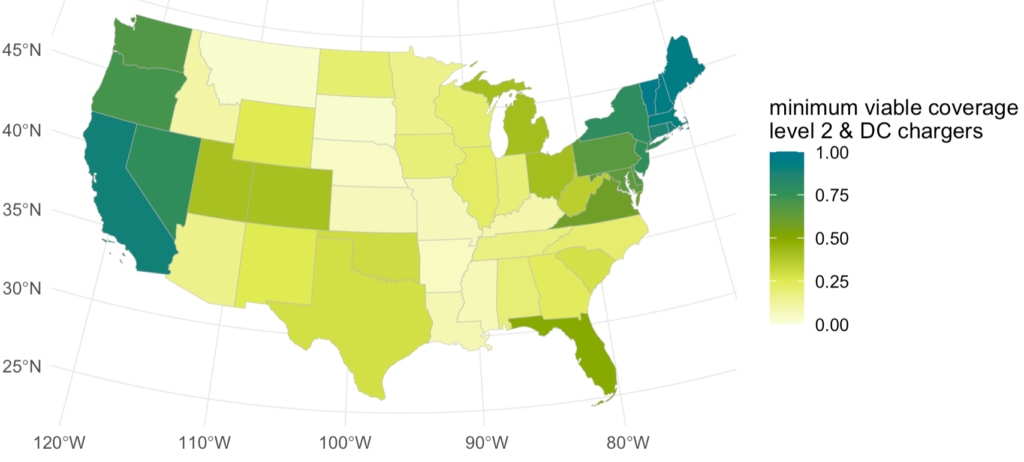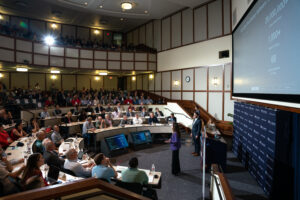Cross Sector
September 12, 2023—In early 2022, the Wells Fargo Innovation Incubator (IN²) chose seven winners for its sixth Channel Partner Strategic Awards cycle. This funding addresses gaps in the cleantech ecosystem and aims to eliminate barriers startups face on the road to commercialization.
Many awardees focused on improving diversity, equity, and inclusion support, thereby driving significant change for underserved communities often most affected by climate change. This community is just as essential as any other to the energy transition because for it to work, it must be everyone. Here is the story of how two of the winners used their awards and the impact they made in just one year:
Carnegie Mellon University
As Dr. Destenie Nock strolled through her old neighborhood in Pittsburgh, she realized most of the houses do not have off-street parking, let alone a garage, and an idea struck her.
“I work in the electricity space, and even I find it difficult to fathom getting an electric vehicle (EV) because I cannot charge it in my house,” said Nock, an assistant professor at Carnegie Mellon University in Civil and Environmental Engineering. “As we electrify transportation, equity must be at the forefront. I want to answer the question: what does an equitable charging system look like?”
That is why she sought out Dr. Corey Harper, also an assistant professor at Carnegie Mellon University in Civil and Environmental Engineering, who regularly focuses on equity issues.
“We knew there were several states and automakers making EV-related promises,” Harper said. “So our preliminary work was to understand where the chargers are right now. We learned they are often concentrated in central business districts, where many in the area don’t have easy access. If we are going to put all these EVs out on the road, then we must have the infrastructure. Up until now, equity hasn’t been a focal point; installers have just been thinking about where the demand is.”
Nock and Harper started by making a map of existing EV charging stations on an island off the coast of San Diego. Then they added a layer of where the stations should be if installers placed them in an equitable way. They recommended having charging stations near the end of the narrow island, where people live, far from the city center. It is unrealistic to expect people will drive into the city every evening to charge their cars overnight.

A map of the U.S. displaying minimum viable EV charging coverage in 2023 aggregated to the state level (weighted by vehicle registration). Photo courtesy of Lily Hanig
With the funding assistance from the IN2 Channel Partner network, Nock said they were able to scale. Moving beyond small towns, they now have maps of four states, and they continue to work on a nationwide map.
“We’re evaluating if current policies will facilitate actually traveling from New York to California,” Nock said. “Our map is going to highlight deficits the same way it would highlight where there are no gas stations. That’s what we’re doing here with EVs—identifying the inequities and pinpointing where people are going to have problems charging.”
Nock and Harper will visit NREL this summer to meet with researchers. The plan is to complete the national map by the end of 2023 and provide it to policymakers to support decision-making.
“Our maps will show state and local policymakers where we need incentives for EV charging station deployment,” Nock said. “If you don’t want to sell any more gasoline vehicles, here are your gaps in charging. We want decisionmakers to understand where those inequities are located before we mandate EV use because the people who are going to be left behind in the transition are the ones we are going to find and address first.”
Both think the connection with NREL’s world-class facilities and team will continue to prove invaluable.
“We’re able to answer some questions here at Carnegie Melon, but NREL really broadened our scope of EV research,” Harper said. “We can use their tools and assess new metrics, such as the health impacts of deploying charging infrastructure. This tool could really help policymakers make decisions that will lead to a more equitable ecosystem.”
Rice Alliance for Technology and Entrepreneurship
Since 2001, the Rice Alliance for Technology and Entrepreneurship has held the Rice Business Plan Competition (RBPC), the self-proclaimed largest and richest intercollegiate startup competition. Teams of student-led startups participate in a pitch competition for millions of dollars in cash and prizes at the Jones Graduate School of Business at Rice University. Its alumni have gone on to raise more than $5 billion in funding, but in 2022, the planners led an initiative to bring about change.
“We wanted to increase the number of diverse energy startups in the competition, which focuses on a range of industries,” said Catherine Santamaria, director of the RBPC, part of the Rice University Business School in Houston, Texas. “This process gave me more ideas and more tools to increase our outreach and the number of ways to attract diverse startups.”
The RBPC requires that at least one member of the team be a graduate student, other members may also be students or industry professionals, and applications are open to universities around the world. The competition aims to give students a real-world experience of what it is like to pitch to investors. At times, there are 30-40 judges in a room, scoring teams and moving the best forward, but also providing feedback on strategy and presentation.
“The expectation is that these student startups will actually go on and form as a company,” Santamaria said. “We want the startup to be their job after they leave the university.”
Historically, the team wasn’t meeting their own goals for engaging with diverse-led startups, but that began to change with help from the IN2 Channel Partner award. Through building deeper relationships with historically black colleges and universities (HBCUs) and minority serving institutions (MSIs), among other efforts, they began to see a shift in both applicants and participants.

The Rice Business Plan Competition is the largest and richest intercollegiate startup competition where teams of student-led startups pitch for millions of dollars in cash and prizes. Photo courtesy of Rice Alliance for Technology and Entrepreneurship
“About half of the energy companies included women founders on the teams,” said Brad Burke, managing director of the Rice Alliance for Technology and Entrepreneurship, which is Rice University’s internationally recognized initiative devoted to the support of entrepreneurship. “We’re working on the other side of the equation as well—the judges. We’d like to ensure that our competitors have access to a diverse group of judges who have an understanding of their journeys and can support them as they pursue their startups.”
As for participants in the RBPC, in 2022, six startups competed in the energy sector category and two were led by a diverse founder. In 2023, 12 teams competed and at least half were diversely led. The hope is to expand those numbers in 2024 and make an impact beyond the competition.
“When you look at venture capital in this country and others, too few of the selected companies have diverse founding teams,” Burke said. “One way to change that is to go upstream, back to the university level. If we can support more diverse founders while they are still students, we hope they go on to launch multiple startups and get funding in the rest of the world.”
The Rice Alliance for Technology and Entrepreneurship was one of the first to join the IN2 Channel Partner network and is grateful for its ongoing support.
“Being in the network is a wonderful way to connect to others who are doing similar work, to learn about what others are doing, and to work together to promote entrepreneurship in the energy space,” Santamaria said. “I’m thankful I’ve been able to come into this community.”
